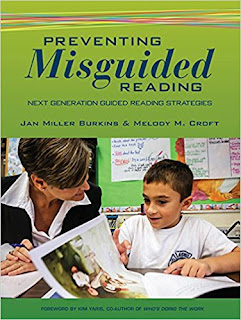Now I'm reading Preventing Misguided Reading: Next Generation Guided Reading Strategies and it has really gotten me thinking about what happens at the guided reading table.
In the gradual release of responsibility model guided reading comes right after shared reading and right before independent reading - meaning that the direct teaching of reading skills and strategies should occur largely away from the guided reading table, so that this time can be used for actually connecting them while reading text.
The strategies and reading behaviors that students practice at the guided reading table should not be new to them. They should be those that have already been taught, modeled, and practiced together during read-aloud and shared reading.
The teacher's primary role in guided reading is not to teach, but to observe in order to determine what they need to revisit with their read aloud (modeled) and shared (interactive) reading lessons.
Remember... guided reading is the point in the release of responsibility right before independence. Scaffolding students toward independence in guided reading is not about the teacher knowing how to hold the reader up, but rather it is about knowing how to let the reader go.
Guided reading should be viewed as a session rather than a lesson. Well-thought-out text selection facilitates what happens during guided reading, thus making it more like a session than a lesson.
Guided reading sessions should be where students use the bulk of their time practicing what they've already learned. A student's main undertaking should be reading the text mostly by themselves. The teacher may need to occasionally help students focus, problem-solve, connect and/or discover, but these moments should only be "brief detours" in the session.
There is much more to say and think about in regards to how, we as teachers, turn our guided reading lessons into guided reading sessions. Over the next several weeks we will dig deeper into this idea.
So... I leave you with this question... What are you doing with students at the guided reading table? Are you using all of the time to teach skills, work on new vocabulary, or introduce the book? or are you giving your students time to practice all of those things you've already modeled for and taught them, so that they are ready for independence?



















